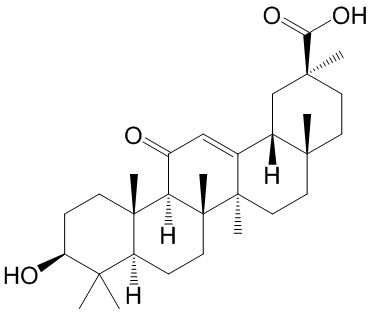Home
Products
Glycyrrhetinic acid



| Product Name | Glycyrrhetinic acid |
| Price: | $15 / 20mg |
| Catalog No.: | CN08116 |
| CAS No.: | 471-53-4 |
| Molecular Formula: | C30H46O4 |
| Molecular Weight: | 470.64 g/mol |
| Purity: | >=98% |
| Type of Compound: | Triterpenoids |
| Physical Desc.: | Powder |
| Source: | The roots of Glycyrrhize glabra L. |
| Solvent: | Chloroform, Dichloromethane, Ethyl Acetate, DMSO, Acetone, etc. |
| SMILES: | O=C1C=C2[C@@H]3C[C@](C)(CC[C@]3(C)CC[C@]2([C@]2([C@H]1[C@@]1(C)CC[C@@H](C(C1CC2)(C)C)O)C)C)C(=O)O |
| Contact us | |
|---|---|
| First Name: | |
| Last Name: | |
| E-mail: | |
| Question: | |
| Description | 18β-Glycyrrhetinic acid is the major bioactive component of Glycyrrhizae Radix and possesses anti-ulcerative, anti-inflammatory and antiproliferative properties. |
| Target | Human Endogenous Metabolite |
| In Vitro | 18β-Glycyrrhetinic acid is the major bioactive component of Glycyrrhizae Radix and possesses anti-ulcerative, anti-inflammatory and antiproliferative properties. MTS assay demonstrates that 24 h treatment of 18β-Glycyrrhetinic acid suppresses cell proliferation in both cell lines in a dose-dependent manner. 18β-Glycyrrhetinic acid at 160 μM significantly decreases the percentage of viable cells to around 40.5±10.5% in A549 and 38.3±4.6% in NCI-H460 (p<0.01 respectively). When the cells are treated with 320 μM 18β-Glycyrrhetinic acid, a greater inhibitory effects on cell proliferation is shown, as the percentage of viable cells is below 30% compare with untreated controls (p<0.001). Treatment with 18β-Glycyrrhetinic acid at 160 μM and 320 μM decreases the levels of full-length PARP and increases the levels of cleaved-PARP[1]. |
| In Vivo | Rats in 18β-Glycyrrhetinic acid+Triptolide (TP) group which receive low-dose 18β-Glycyrrhetinic acid (50 mg/kg) have significant reductions in the three serum parameters when compare with TP rats. Rats in 18β-Glycyrrhetinic acid+TP group which receive the high-dose 18β-Glycyrrhetinic acid (100 mg/kg) have slightly lowered the levels of three liver enzymes, the reductions do not reach statistical significance compare with TP group. Contrastingly, preadministration of low-dose 18β-Glycyrrhetinic acid protects animals from TP-induced hepatic lesions. On the contrary, low-dose 18β-Glycyrrhetinic acid (50 mg/kg) markedly suppresses the release of the four cytokines above[3]. |
| Cell Assay | Primary microglia cultures are used in this study. For treatment assay, microglia are incubated with complete DMEM and stimulated with or without 100 ng/mL IFN-γ in the presence or absence of 18β-Glycyrrhetinic acid (25 μM and 50 μM) at 37°C in a humidified incubator with 5% CO2. For cell migration assay, the isolated primary microglia that seeded in complete DMEM medium are stimulated with or without IFN-γ (100 ng/mL), and treated with different doses of 18β-Glycyrrhetinic acid, 24 h later, the microglia culture supernatants are collected and added to the lower chambers of Transwell inserts[2]. |
| Animal Admin | Healthy Wistar rats (male, 200±20 g) are used and divided into five groups with 10 individuals for each group randomly. Animals in normal control (NC) group receive distilled water for 6 days and 0.5% CMC-Na for the last 3 days. Rats in Triptolide model group (TP), 18β-Glycyrrhetinic acid low-dose group (GAL+TP), and 18β-Glycyrrhetinic acid high-dose group (GAH+TP) receive distilled water, 18β-Glycyrrhetinic acid (50 mg/kg, p.o., dissolved in distilled water), or 18β-Glycyrrhetinic acid (100 mg/kg, p.o., dissolved in distilled water) for consecutive 6 days, respectively, and liver injury is induced by TP (2.4 mg/kg, p.o., suspended in 0.5% CMC-Na) for the last 3 days. Animals in the above three groups receive TP 6 hours after distilled water or 18β-Glycyrrhetinic acid treatment on the last 3 days[3]. |
| Density | 1.1±0.1 g/cm3 |
| Boiling Point | 588.3±50.0 °C at 760 mmHg |
| Flash Point | 323.7±26.6 °C |
| Exact Mass | 470.339600 |
| PSA | 74.60000 |
| LogP | 6.57 |
| Vapour Pressure | 0.0±3.7 mmHg at 25°C |